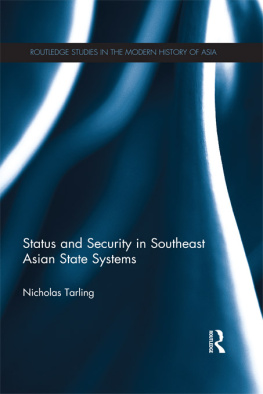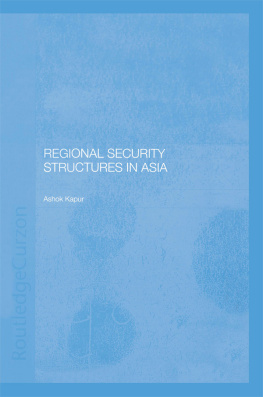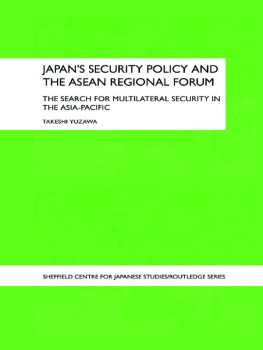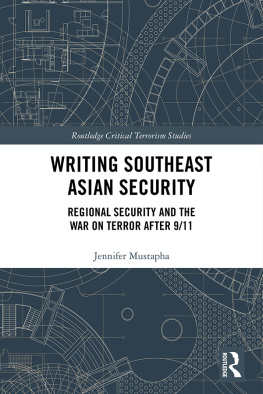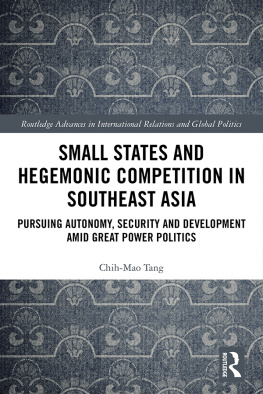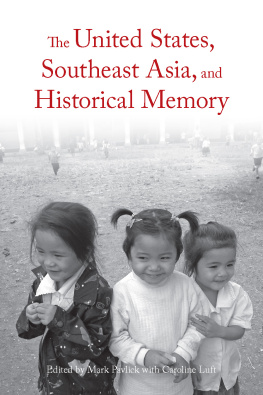GEOPOLITICS IN THE 21ST CENTURY
For a quarter century since the fall of the Berlin Wall, the world has enjoyed an era of deepening global interdependence, characterized by the absence of the threat of great power war, spreading democracy, and declining levels of conflict and poverty. Now, much of that is at risk as the regional order in the Middle East unravels, the security architecture in Europe is again under threat, and great power tensions loom in Asia.
The Geopolitics in the 21st Century series, published under the auspices of the Order from Chaos project at Brookings, will analyze the major dynamics at play and offer ideas and strategies to guide critical countries and key leaders on how they should act to preserve and renovate the established international order to secure peace and prosperity for another generation.
AMBIVALENT ENGAGEMENT
THE UNITED STATES AND REGIONAL SECURITY IN SOUTHEAST ASIA AFTER THE COLD WAR
JOSEPH CHINYONG LIOW
Brookings Institution Press
Washington, D.C.
Copyright 2017
THE BROOKINGS INSTITUTION
1775 Massachusetts Avenue, N.W., Washington, D.C. 20036
www.brookings.edu
All rights reserved. No part of this publication may be reproduced or transmitted in any form or by any means without permission in writing from the Brookings Institution Press.
The Brookings Institution is a private nonprofit organization devoted to research, education, and publication on important issues of domestic and foreign policy. Its principal purpose is to bring the highest quality independent research and analysis to bear on current and emerging policy problems. Interpretations or conclusions in Brookings publications should be understood to be solely those of the authors.
Library of Congress Cataloging-in-Publication data
Names: Liow, Joseph Chinyong, 1972 author.
Title: Ambivalent engagement : the United States and regional security in Southeast Asia after the Cold War / Joseph Chinyong Liow.
Description: Washington, D.C. : Brookings Institution Press, [2017] | Includes bibliographical references.
Identifiers: LCCN 2017010288 (print) | LCCN 2017012103 (ebook) | ISBN 9780815729686 | ISBN 9780815729679 | ISBN 9780815729679 (hardcover : alk. paper) | ISBN 9780815729686 (ebook)
Subjects: LCSH: United StatesForeign relationsSoutheast Asia. | Southeast AsiaForeign relationsUnited States. | National securityUnited States. | National securitySoutheast Asia. | United StatesForeign Relations20012009. | United StatesForeign relations2009
Classification: LCC DS525.9.U6 (ebook) | LCC DS525.9.U6 L56 2017 (print) | DDC 355/.0330959dc23
LC record available at https://lccn.loc.gov/2017010288
9 8 7 6 5 4 3 2 1
Typeset in Sabon and Scala Sans
Composition by Westchester Publishing Services
Dedicated to the memory of
S. R. Nathan
July 3, 1924August 22, 2016
Contents
Preface
BY THE END OF the Second World War, Southeast Asia had emerged as a region of growing strategic import to the United States. Wartime circumstances had compelled Washington to reassess its role in the wider Asia Pacific region. Although the United States had been hitherto reluctant to enter the war, the surprise attack on Pearl Harbor provoked an American response that by August 1945 transformed the country into a global superpower with global strategic interests. As the Second World War gave way to the Cold War, Southeast Asia became a major geopolitical shatterbelt, defined as strategically oriented regions that are both deeply divided internally and caught up in the competition between great powers of the geostrategic realms. For the United States, Southeast Asia assumed crucial importance to the grand strategy of containment designed to curb the growth of communism, which proved a particularly appealing ideology to elements within the anticolonial movements of the region. This grand strategy, predicated on the domino theory (namely, the belief that the falling of any regime in Southeast Asia into communist hands would trigger a domino effect), eventually culminated in the United States doomed involvement in Vietnam. Etched deep into the American psyche, the Vietnam War eventually created a distaste for the deployment of American troops in military expeditions overseas and prompted a reassessment of the place of Southeast Asia in the wider strategic interests of the United States. For the rest of the Cold War, Southeast Asia fell off the American foreign policy radar.
In the meantime, American ambivalence toward the region ushered in an era of policy neglect in U.S.Southeast Asian relations, which exercised the noncommunist regional states throughout the 1980s.
Regional concerns were hardly placated by the uncertainties that confronted Southeast Asia at the end of the Cold War, especially when a major strategic reassessment of American global interests and priorities undertaken by the Clinton administration prompted speculative murmurs of American withdrawal from the Asia Pacific region. Although what eventually transpired was more a reordering of American foreign policy priorities rather than outright withdrawal, it nevertheless was interpreted in Southeast Asian capitals as a major downgrading of the regions importance in Washingtons larger postCold War grand strategy, to the extent that one could be discerned. Attempts by American officials to explain this retrenchment using a congenial syllogismthat Southeast Asia was more peaceful compared with other regions in the world and hence there was no urgency for a strong U.S. presencedid little to assuage these fears. Conventional wisdom further holds that the lapse of American leases to Philippine military bases in the early 1990s and the subsequent withdrawal of U.S. military forces served to register a manifestation of this retrenchment, even though Philippine domestic political circumstances also doubtless played a part in hastening the U.S. departure.
If the Clinton administrations Southeast Asia policy can be described as neglect, or even estrangement in the words shared to me by a senior Singaporean diplomat, the administrations of George W. Bush and Barack Obama saw something of a reinvigoration of American interest in the region, albeit for different reasons and with different outcomes. Most would agree that the foreign and security policy of the Bush presidency was defined by the signal issue of the war on terrorism. In that respect, Southeast Asia was no different. Indeed, with neoconservative hands firmly on the levers of national power, the Bush administrations fixation with the war on terrorism focused American energy and resources on maritime Southeast Asia, home to a number of extremist groups (even though many were at the time in fact opportunistic ragtag bandits), especially after the Bali bombings of 2002 and revelations that al Qaeda had attempted to gain a foothold in the region through unholy alliances with these groups. This prioritization of maritime Southeast Asia and tendency toward an issue-focus outlook meant that the regions mainland states commanded significantly less U.S. attention. In hindsight, the growing influence that China has come to command in regional affairs can arguably be traced to this period, when American inattentiveness to mainland Southeast Asian states like Cambodia and Laos inadvertently offered China greater leverage.
The Obama administration attempted to rectify the narrow focus of the Bush administration with the introduction of the Pivot to Asia. In her important November 2011 article in Foreign Policy magazine, then secretary of state Hillary Clinton heralded the coming of a Pacific Century. This was hardly a hyperbolic declaration. Secretary Clintons widely read article, which she carefully titled Americas Pacific Century, and President Obamas speech before the Australian Parliament in Canberra that same month together introduced the administrations Pivot to Asia policy. The Pivot, which has since been rechristened the Rebalance, was meant to be a comprehensive strategy encompassing distinct diplomatic, economic, and military elements, which are collectively aimed at reorienting U.S. grand strategy toward this increasingly vital part of the world. By the advent of the second Obama term, discussions in policy circles both in Washington and in Southeast Asian capitals were talking about a pivot within the Pivot, with Southeast Asia coming to command an even larger share of American resource, focus, and attention.


